实现目标
1、在本地部署大语言模型,实现本地的聊天机器人;
2、适应本地较低计算力的计算机;
3、支持查看与机器人聊天的历史记录;
进阶(未实现):
4、经过测试,发现问答是纯英语时的问答比较正常。如果是中文提问,机器人可能会胡言乱语。因此,需要增加翻译模块,将问题转为英语,并将回答转为中文;
5、使用完整的部署框架,比如nginx+uWSGI+flask等方式将此机器人部署到云服务器中。
环境
mysql 8.0.37
python 3.11.2
poetry 1.7.1
Flask 3.0.3
torch 2.3.0
transformers 4.41.0
accelerate 0.30.1
mysql-connector-python 8.4.0
在运行整个项目前还需要保证mysql数据库已经安装完毕,并且root用户的密码为abc12345,否则需要修改代码当中的访问用户名与用户名密码。

实现过程
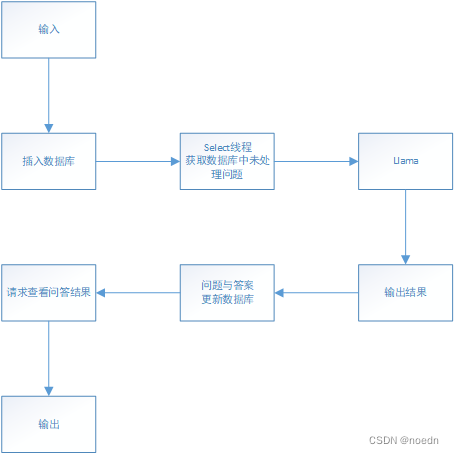
为了完成预定好的功能,首先本地完成MySQL数据库在本地的实现。创建的数据库包含的列包含主键id、问题插入数据库时间、结果插入数据库时间、问题、结果和问题是否处理的标记位。
CREATE TABLE IF NOT EXISTS process_bot(
id BIGINT AUTO_INCREMENT PRIMARY KEY, # 主键
get_data_time DATETIME NOT NULL, # 问题插入数据库时间
result_time DATETIME NULL, # 结果插入数据库时间
process_data TEXT NULL, # 问题
process_data_sha256 CHAR(64) NULL, # 问题的sha256值,用于查询
result_data TEXT NULL, # 结果
processed_flag TINYINT(1) DEFAULT 0 NOT NULL # 问题是否已经处理的标记位
)
在测试数据库实现中,防止作为主键的id的值用尽,使用BIGINT数据类型,基本不用担心id用尽。同时,为了解决问题插入数据库时,问题字符串当中存在的换行导致的数据库语法错误。将所有字符串使用base64编码,并在从数据库中取出时使用base64解码,解决由于换行等字符导致的插入数据库时的语法报错问题。
所有源代码
一、项目代码目录结构:
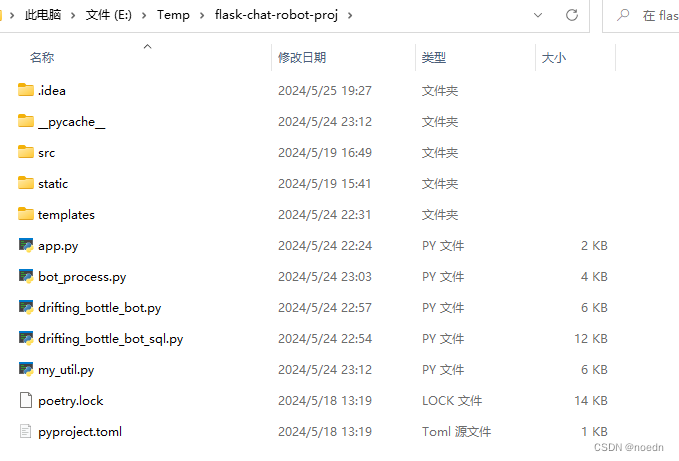
目录文件夹和文件作用说明:
1、src文件夹:web页面图片资源;

2、static文件夹:css文件夹是boostrap框架的静态文件,用于控制web页面的样式;fonts文件夹是字体文件夹;model文件夹是聊天机器人的模型参数文件夹,模型来源【 https://gitee.com/link?target=https%3A%2F%2Fhf-mirror.com%2FTinyLlama%2FTinyLlama-1.1B-Chat-v1.0 】;src文件夹其他(不需要)。
3、templates文件夹是web页面的html文件保存目录;
4、app.py文件是flask程序的入口函数文件;
5、bot_process.py文件是机器人web页面响应实现;
6、drifting_bottle_bot.py文件是机器人处理问题实现;
7、drifting_bottle_bot_sql.py文件是数据库处理实现;
8、mu_util.py文件是本人收集实现的一些工具函数文件。
二、src文件夹

三、templates文件夹

bot_history_page.html
<!DOCTYPE html>
<html lang="zh-CN">
<head>
<meta charset="UTF-8">
<title>历史结果</title>
<link rel="stylesheet" href="/static/css/bootstrap.css">
<style>
/*static 文件夹是默认用于存放静态文件的,比如 CSS、JavaScript、图片和字体文件等。
Flask 会自动为 static 文件夹下的所有文件提供静态文件的路由,使得这些文件可以被直接访问,
而不需要你为每个文件单独编写路由。*/
@font-face {
font-family: 'KingHwa'; /* 自定义字体名称 */
/*此处将字体文件加入到static文件夹当中,就省去了编写路由的工作,ttf文件对应路由格式truetype*/
src: url('../static/fonts/KingHwa_OldSong.ttf') format('truetype');/* 字体文件路径和格式 */
font-weight: normal;
font-style: normal;
}
body {
background-color: rgba(173, 216, 230, 0.5); /*设置页面背景颜色*/
font-family: "KingHwa", sans-serif; /*设置字体*/
}
.center-image {
/*position: fixed;*/
display: block;
margin-top: 4%;
margin-left: 40%;
margin-right: 40%;
border-radius: 4%; /* 设置圆角大小 */
width: 20%; /* 你可以根据需要调整宽度 */
}
.center-bnt {
/*position: fixed;*/
display: block;
{#margin-top: 10%;#}
margin-top: 5%;
margin-left: 45%;
margin-right: 45%;
width: 10%; /* 你可以根据需要调整宽度 */
}
.rounded-font {
display: block;
margin-top: 8%;
border-radius: 2%; /* 设置圆角大小 */
font-size: 360%; /* 设置字体大小 */
text-align: center; /* 将文本居中 */
}
#backToTop {
position: fixed;
bottom: 20px;
right: 30px;
z-index: 99;
border: none;
outline: 1px solid black;/*设置轮廓*/
background-color: rgba(0, 0, 230, 0.5);
color: white;
cursor: pointer;
padding: 4px 5px;
border-radius: 2px;/*设置圆角*/
}
.default-img {
/*position: fixed;*/
display: block;
{#margin-top: 10%;#}
{#margin-top: 5%;#}
margin-left: 30%;
margin-right: 30%;
width: 20%; /* 你可以根据需要调整宽度 */
border-radius: 2%;/*设置圆角*/
}
.back-home {
position: fixed;
bottom: 15px; /* 初始时,将元素移出视口 */
right: 100px;
/* 其他样式 */
}
</style>
</head>
<h1 class="rounded-font">查询历史</h1>
<body>
<table class="table" style="width: 95%;margin:10% auto;">
<thead>
<tr>
<th scope="col">ID</th>
<th scope="col">提交时间</th>
<th scope="col">结果时间</th>
<th scope="col">问题</th>
<th scope="col">答案</th>
</tr>
</thead>
<tbody>
{% for bot in data %}
<tr>
<td>{{ bot.id }}</td>
<td>{{ bot.atime }}</td>
<td>{{ bot.qtime }}</td>
<td>{{ bot.question }}</td>
<td>{{ bot.answer }}</td>
<td><a href="/botQA?id={{ bot.id }}">详情</a></td>
</tr>
{% endfor %}
</tbody>
</table>
<a href="{{ url_for('bot_process.bot_submit')}}" class="back-home">返回首页</a>
<button onclick="topFunction()" id="backToTop" title="回到顶部">
<img src="{{ url_for('send_image', path='src/toTop.jpg') }}" alt="返回顶部">
</button>
<script>
function topFunction() {
window.scrollTo(0, 0);
}
</script>
</body>
</html>
bot_QA_page.html
<!DOCTYPE html>
<html lang="zh-CN">
<head>
<meta charset="UTF-8">
<title>问答结果</title>
<link rel="stylesheet" href="/static/css/bootstrap.css">
<style>
/*static 文件夹是默认用于存放静态文件的,比如 CSS、JavaScript、图片和字体文件等。
Flask 会自动为 static 文件夹下的所有文件提供静态文件的路由,使得这些文件可以被直接访问,
而不需要你为每个文件单独编写路由。*/
@font-face {
font-family: 'KingHwa'; /* 自定义字体名称 */
/*此处将字体文件加入到static文件夹当中,就省去了编写路由的工作,ttf文件对应路由格式truetype*/
src: url('../static/fonts/KingHwa_OldSong.ttf') format('truetype');/* 字体文件路径和格式 */
font-weight: normal;
font-style: normal;
}
body {
background-color: rgba(173, 216, 230, 0.5); /*设置页面背景颜色*/
font-family: "KingHwa", sans-serif; /*设置字体*/
}
.center-image {
/*position: fixed;*/
display: block;
margin-top: 4%;
margin-left: 40%;
margin-right: 40%;
border-radius: 4%; /* 设置圆角大小 */
width: 20%; /* 你可以根据需要调整宽度 */
}
.center-bnt {
/*position: fixed;*/
display: block;
{#margin-top: 10%;#}
margin-top: 5%;
margin-left: 45%;
margin-right: 45%;
width: 10%; /* 你可以根据需要调整宽度 */
}
.rounded-font {
display: block;
margin-top: 8%;
border-radius: 2%; /* 设置圆角大小 */
font-size: 360%; /* 设置字体大小 */
text-align: center; /* 将文本居中 */
}
#backToTop {
position: fixed;
bottom: 20px;
right: 30px;
z-index: 99;
border: none;
outline: 1px solid black;/*设置轮廓*/
background-color: rgba(0, 0, 230, 0.5);
color: white;
cursor: pointer;
padding: 4px 5px;
border-radius: 2px;/*设置圆角*/
}
.default-img {
/*position: fixed;*/
display: block;
{#margin-top: 10%;#}
{#margin-top: 5%;#}
margin-left: 30%;
margin-right: 30%;
width: 20%; /* 你可以根据需要调整宽度 */
border-radius: 2%;/*设置圆角*/
}
.back-home {
position: fixed;
bottom: 15px; /* 初始时,将元素移出视口 */
right: 100px;
/* 其他样式 */
}
.bottom_left {
position: fixed;
bottom: 15px; /* 初始时,将元素移出视口 */
left: 100px;
/* 其他样式 */
}
</style>
</head>
<h1 class="rounded-font">问答结果</h1>
<body>
<form action="/procs" method="post" enctype = "multipart/form-data">
<div class="row">
<div class="mb-3">
<label for="inputQuestion" class="form-label">问题:</label>
<textarea class="form-control" id="inputQuestion" rows="10" readonly>{{ data.question }}</textarea>
</div>
<div class="mb-3">
<label for="inputQuestion" class="form-label">答案:</label>
<textarea class="form-control" id="inputQuestion" rows="10" readonly>{{ data.answer }}</textarea>
</div>
</div>
</form>
<br/>
<br/>
<br/>
<br/>
<a href="{{ url_for('bot_process.bot_history')}}" class="bottom_left">历史数据</a>
<a href="{{ url_for('bot_process.bot_submit')}}" class="back-home">返回首页</a>
{# <button onclick="topFunction()" id="backToTop" title="回到顶部">#}
{# <img src="{{ url_for('send_image', path='src/toTop.jpg') }}" alt="返回顶部">#}
{# </button>#}
<script>
function topFunction() {
window.scrollTo(0, 0);
}
</script>
</body>
</html>
bot_question_page.html
<!DOCTYPE html>
<html lang="zh-CN">
<head>
<meta charset="UTF-8">
<title>提交问题</title>
<link rel="stylesheet" href="/static/css/bootstrap.css">
<style>
/*static 文件夹是默认用于存放静态文件的,比如 CSS、JavaScript、图片和字体文件等。
Flask 会自动为 static 文件夹下的所有文件提供静态文件的路由,使得这些文件可以被直接访问,
而不需要你为每个文件单独编写路由。*/
@font-face {
font-family: 'KingHwa'; /* 自定义字体名称 */
/*此处将字体文件加入到static文件夹当中,就省去了编写路由的工作,ttf文件对应路由格式truetype*/
src: url('../static/fonts/KingHwa_OldSong.ttf') format('truetype');/* 字体文件路径和格式 */
font-weight: normal;
font-style: normal;
}
body {
background-color: rgba(173, 216, 230, 0.5); /*设置页面背景颜色*/
font-family: "KingHwa", sans-serif; /*设置字体*/
}
.center-image {
/*position: fixed;*/
display: block;
margin-top: 4%;
margin-left: 40%;
margin-right: 40%;
border-radius: 4%; /* 设置圆角大小 */
width: 20%; /* 你可以根据需要调整宽度 */
}
.center-bnt {
/*position: fixed;*/
display: block;
{#margin-top: 10%;#}
margin-top: 5%;
margin-left: 45%;
margin-right: 45%;
width: 10%; /* 你可以根据需要调整宽度 */
}
.rounded-font {
display: block;
margin-top: 8%;
border-radius: 2%; /* 设置圆角大小 */
font-size: 360%; /* 设置字体大小 */
text-align: center; /* 将文本居中 */
}
#backToTop {
position: fixed;
bottom: 20px;
right: 30px;
z-index: 99;
border: none;
outline: 1px solid black;/*设置轮廓*/
background-color: rgba(0, 0, 230, 0.5);
color: white;
cursor: pointer;
padding: 4px 5px;
border-radius: 2px;/*设置圆角*/
}
.default-img {
/*position: fixed;*/
display: block;
{#margin-top: 10%;#}
{#margin-top: 5%;#}
margin-left: 30%;
margin-right: 30%;
width: 20%; /* 你可以根据需要调整宽度 */
border-radius: 2%;/*设置圆角*/
}
.back-home {
position: fixed;
bottom: 15px; /* 初始时,将元素移出视口 */
right: 100px;
/* 其他样式 */
}
.bottom_left {
position: fixed;
bottom: 15px; /* 初始时,将元素移出视口 */
left: 100px;
/* 其他样式 */
}
</style>
</head>
<h1 class="rounded-font">提交问题</h1>
<body>
<div class="container">
<form action="/procs" method="post" enctype = "multipart/form-data">
<div class="row">
<div class="mb-3">
<label for="inputQuestion" class="form-label">问题:{{ status }}</label>
<textarea class="form-control" id="inputQuestion" rows="20" placeholder="输入" name="questionTxt"></textarea>
</div>
<div style="display: grid; justify-content: end;">
<button type="submit" class="btn btn-primary">提交</button>
</div>
</div>
</form>
<a href="{{ url_for('bot_process.bot_history')}}" class="bottom_left">历史数据</a>
</div>
<a href="{{ url_for('welcome')}}" class="back-home">退出</a>
</button>
<script>
function topFunction() {
window.scrollTo(0, 0);
}
</script>
</body>
</html>
home_page.html
<!DOCTYPE html>
<html lang="zh-CN">
<head>
<meta charset="UTF-8">
<title>开始页面</title>
<link rel="stylesheet" href="/static/css/bootstrap.css">
<style>
/*static 文件夹是默认用于存放静态文件的,比如 CSS、JavaScript、图片和字体文件等。
Flask 会自动为 static 文件夹下的所有文件提供静态文件的路由,使得这些文件可以被直接访问,
而不需要你为每个文件单独编写路由。*/
@font-face {
font-family: 'KingHwa'; /* 自定义字体名称 */
/*此处将字体文件加入到static文件夹当中,就省去了编写路由的工作,ttf文件对应路由格式truetype*/
src: url('../static/fonts/KingHwa_OldSong.ttf') format('truetype');/* 字体文件路径和格式 */
font-weight: normal;
font-style: normal;
}
body {
background-color: rgba(173, 216, 230, 0.5); /*设置页面背景颜色*/
font-family: "KingHwa", sans-serif; /*设置字体*/
}
.center-image {
/*position: fixed;*/
display: block;
margin-top: 4%;
margin-left: 40%;
margin-right: 40%;
border-radius: 4%; /* 设置圆角大小 */
width: 20%; /* 你可以根据需要调整宽度 */
}
.center-bnt {
/*position: fixed;*/
display: block;
{#margin-top: 10%;#}
margin-top: 5%;
margin-left: 45%;
margin-right: 45%;
width: 10%; /* 你可以根据需要调整宽度 */
}
.rounded-font {
display: block;
margin-top: 8%;
border-radius: 2%; /* 设置圆角大小 */
font-size: 360%; /* 设置字体大小 */
text-align: center; /* 将文本居中 */
}
#backToTop {
position: fixed;
bottom: 20px;
right: 30px;
z-index: 99;
border: none;
outline: 1px solid black;/*设置轮廓*/
background-color: rgba(0, 0, 230, 0.5);
color: white;
cursor: pointer;
padding: 4px 5px;
border-radius: 2px;/*设置圆角*/
}
</style>
</head>
<h1 class="rounded-font">漂流瓶机器人</h1>
<img src="{{ url_for('send_image', path='src/bottle.jpg') }}" alt="标题图片" class="center-image">
<body>
<form style="width:100%;margin:2% auto;" method="post">
<button type="submit" class="btn btn-primary center-bnt" style="font-size: 150%">进入聊天</button>
</form>
</button>
<script>
function topFunction() {
window.scrollTo(0, 0);
}
</script>
</body>
</html>
四、各个python实现文件
app.py
from flask import Flask, render_template, request, redirect, send_file
import requests
import os
import bot_process
from drifting_bottle_bot import bot_init, bot_quit
from drifting_bottle_bot_sql import bot_sql_init, bot_sql_quit
import signal
import sys
app = Flask(__name__) # 创建app对象
# 设置配置
SOURCE_FOLDER = os.path.join(app.root_path, 'static', 'src') # 图片资源
app.config['SOURCE_FOLDER'] = SOURCE_FOLDER
BOT_MODEL_FOLDER = os.path.join(app.root_path, 'static', 'model') # 漂流瓶机器人模型
app.config['BOT_MODEL_FOLDER'] = BOT_MODEL_FOLDER
# 注册路由和其他配置
app.register_blueprint(bot_process.blueprint) # 图片识别蓝图注册
# 初始化后端
bot_sql_init()
bot_init()
@app.route('/src/<path:path>')#网页的所有文件都是来自服务器
def send_image(path):
return send_file(path, mimetype='image/jpeg')
@app.route('/')#访问的路径
def hello_world():
return redirect('/welcome')#根路径开始,跳转登陆
return 'Hello system!'
@app.route('/welcome', methods=['GET', 'POST'])#访问的路径
def welcome():
if request.method == 'POST':
return redirect('/procs')#未实现返回功能选项首页
return render_template('home_page.html')
# 释放资源清理函数
def cleanup():
# 释放资源
print("退出,释放资源...")
bot_quit()
bot_sql_quit()
print("成功退出!")
pass
# 注册信号处理函数
def signal_handler(sig, frame):
print(f'收到信号: {sig}, 关闭 Flask 应用')
cleanup() # 释放资源清理函数
sys.exit(0) # 退出程序
# 设置信号处理函数
signal.signal(signal.SIGINT, signal_handler) # SIGINT 对应 Ctrl+C
signal.signal(signal.SIGTERM, signal_handler) # SIGTERM 通常用于优雅地关闭程序
if __name__ == '__main__':
app.run(debug=False) # 阻塞
bot_process.py
from flask import request, url_for, render_template, redirect, Blueprint, current_app
from datetime import datetime
from drifting_bottle_bot import data_to_bot
from drifting_bottle_bot_sql import select_table_opt
from my_util import Logger, decode_base64
# initialize our Flask application and the lpr object
blueprint = Blueprint('bot_process', __name__)
lprObject = None
loger = Logger()
default_pic_name = "defaultPlate.jpg"
MAX_SHOW_LEN = 50 # 历史页面展示的列最大长度
@blueprint.route('/procs', methods=['GET', 'POST']) # 访问的路径
def bot_submit():
status = '未提交'
if request.method == 'POST':
# 获取textarea提交的文本
question = request.form.get("questionTxt")
if question:
loger.info("get question " + question)
data_to_bot(question)
status = '已提交'
else:
loger.warning("none")
return render_template('bot_question_page.html', status=status)
@blueprint.route('/history', methods=['GET', 'POST']) # 访问的路径
def bot_history():
result = select_table_opt(datetime.now(), 9999)
data = []
for row in result:
if row[2] is not None and row[5] is not None:
res_exchange = {'id': int(row[0]), 'atime': row[1], 'qtime': row[2],
'question': decode_base64(row[3])[:MAX_SHOW_LEN], 'answer': decode_base64(row[5])[:2*MAX_SHOW_LEN]}
elif row[2] is not None:
res_exchange = {'id': int(row[0]), 'atime': row[1], 'qtime': row[2],
'question': decode_base64(row[3])[:MAX_SHOW_LEN], 'answer': '未处理'}
else:
res_exchange = {'id': int(row[0]), 'atime': row[1], 'qtime': '未处理',
'question': decode_base64(row[3])[:MAX_SHOW_LEN], 'answer': '未处理'}
loger.debug(res_exchange)
data.append(res_exchange)
return render_template('bot_history_page.html', data=data)
@blueprint.route('/botQA', methods=['GET', 'POST']) # 访问的路径
def bot_QA():
id = request.args.get('id')
loger.debug(f"get id is {id}")
data1 = []
data = select_table_opt(datetime.now(), 9999)
for res in data:
if res[0] == int(id):
data1 = res
loger.debug(f"bot Q/A :{data1}")
break
if data1[2] is not None and data1[5] is not None:
res_exchange = {'id': int(data1[0]), 'atime': data1[1], 'qtime': data1[2],
'question': decode_base64(data1[3]), 'answer': decode_base64(data1[5])}
elif data1[2] is not None:
res_exchange = {'id': int(data1[0]), 'atime': data1[1], 'qtime': data1[2],
'question': decode_base64(data1[3]), 'answer': '未处理'}
else:
res_exchange = {'id': int(data1[0]), 'atime': data1[1], 'qtime': '未处理',
'question': decode_base64(data1[3]), 'answer': '未处理'}
loger.info(f"res_exchange is {res_exchange}")
return render_template('bot_QA_page.html', data=res_exchange)
drifting_bottle_bot.py
'''
https://hf-mirror.com/TinyLlama/TinyLlama-1.1B-Chat-v1.0
测试tinyLlama 1.1B效果不错,比Qwen1.8B经过量化的都好很多
'''
# Install transformers from source - only needed for versions <= v4.34
# pip install git+https://github.com/huggingface/transformers.git
# pip install accelerate
import os
from datetime import datetime
import queue
import time
import threading
import torch
from my_util import Logger, end_sentence, decode_base64
os.environ['TF_ENABLE_ONEDNN_OPTS'] = '0'
from transformers import pipeline
from drifting_bottle_bot_sql import insert_table_opt, update_table_opt, select_table_opt
MAX_QUEUE_SIZE = 10 # 问题消息队列当中最大问题数量
MAX_ANSWER_LEN = 1024 # 机器人回答问题的最大长度
loger = Logger()
def get_substring_after_split(main_string, delimiter):
parts = main_string.split(delimiter)
if len(parts) > 1: # 确保有多个部分
return parts[1].lstrip('\n') # 返回第一个分隔符后面的部分
else:
return None
def load_pipeline():
Q_pipe = pipeline("text-generation", model=os.path.join(os.getcwd(),
"static", "model",
"TinyLlama", "TinyLlama-1.1B-Chat-v1.0"),
torch_dtype=torch.bfloat16,
device_map="auto")
return Q_pipe
def generate_text(content, max_len=MAX_ANSWER_LEN):
"""
根据给定的prompt生成文本
"""
messages = [
{
"role": "提示",
"content": "这是个友好的聊天机器人...",
},
{"role": "user", "content": content},
]
# insert_table_opt(content)
prompt = Q_pipe.tokenizer.apply_chat_template(messages, tokenize=False, add_generation_prompt=True)
datetime1 = datetime.now()
outputs = Q_pipe(prompt, max_new_tokens=max_len, do_sample=True, temperature=0.7, top_k=50, top_p=0.95)
datetime2 = datetime.now()
time12_interval = datetime2 - datetime1
loger.info(f"耗时 {time12_interval}s")
'''
结论:修改top_p不会显著降低推理时间,并且中英文相同的问题,中文问题推理时间是英文的两倍
do_sample修改成False基本不会降低推理时间
只有max_new_tokens才能显著降低推理时间,但是max_new_tokens与推理时间不是呈线性关系
比如max_new_tokens=256,推理时间2分钟
当max_new_tokens=32的时候,推理时间才会变成约1分钟
因此,不如将max_new_tokens设置大些用于获取比较完整的答案
'''
return outputs
# 消费者
def loop_process_bot():
while True:
get_from_db = select_table_opt(datetime.now(), 1, 0)
if not get_from_db:
time.sleep(1) # 如果没有数据则挂起一会
continue
question = decode_base64(get_from_db[0][3])
loger.info(f'[Consuming]: {question}')
loger.info(f"Reading process questions: {question}")
try:
gen_text = generate_text(question)
res = gen_text[0]["generated_text"]
answer = get_substring_after_split(res, "<|assistant|>")
if len(answer):
loger.debug(f"Answer: {answer}")
else:
answer = "I don't know"
loger.error(f"No answer: {answer}")
update_table_opt(question, answer)
res = end_sentence(res, len(res))
loger.debug(f"生成的文本:{res}")
except Exception as e:
loger.error(f"Exception error: {e}")
# 生产者
def question_to_bot(question):
loger.info(f'[Producing]: {question}')
bot_queue.put(question) # 将消息放入队列
# 消费者
def question_to_db():
while True:
question = bot_queue.get() # 从队列中获取消息
if question is None: # 假设None是停止信号
time.sleep(1/1000)
continue
else:
loger.debug(f"get question from queue: {question}")
insert_table_opt(question)
bot_queue.task_done() # 告诉队列该任务已完成
def bot_init():
'''
初始化机器人
:return:
'''
global Q_pipe
Q_pipe = load_pipeline()
loger.info('load pipe ok')
# 创建一个消息队列
global bot_queue
bot_queue = queue.Queue()
loger.info('create bot queue ok')
# 创建消息队列守护线程,使用消息队列控制插入数据库的速度(可以不使用)
global daemon_db_thread
daemon_db_thread = threading.Thread(target=question_to_db)
daemon_db_thread.daemon = True # 设置为守护线程
daemon_db_thread.start() # 启动线程
# 创建聊天机器人守护线程
global daemon_thread
daemon_thread = threading.Thread(target=loop_process_bot)
daemon_thread.daemon = True # 设置为守护线程
daemon_thread.start() # 启动线程
def data_to_bot(question):
'''
传数据给聊天机器人
:param question: 问题
:return:
'''
if len(question) == 0:
return
elif bot_queue.qsize() >= MAX_QUEUE_SIZE:
loger.warning(f"having {MAX_QUEUE_SIZE} questions in queue, waiting ...")
return
else:
loger.info(f"get quesiont {question}")
try:
question_to_bot(question)
except Exception as e:
loger.error("发生错误:", e)
def bot_quit():
'''
退出聊天机器人
:return:
'''
# 等待消费者线程完成所有任务
loger.info("ready to quit bot ...")
bot_queue.join() # 等待队列中所有任务完成
loger.info("queue join ok!")
daemon_thread.join()
loger.info("quit bot ok!")
daemon_db_thread.join()
loger.info("quit queue ok!")
drifting_bottle_bot_sql.py
'''
测试mysql数据库,用于后续使用数据库
'''
import mysql.connector
from mysql.connector import Error
from datetime import datetime
import hashlib
from my_util import Logger, encode_base64
loger = Logger()
mysql_server_ip = 'localhost'
username = 'root'
password = 'abc12345'
database_name = 'test_mysql'
datatable_name = 'process_bot' # 测试漂流瓶机器人数据表
def string_to_sha256(input_string):
# 创建一个新的sha256 hash对象
sha_signature = hashlib.sha256()
# 更新你要哈希的数据(字符串需要被编码为字节)
sha_signature.update(input_string.encode('utf-8'))
# 获取哈希值的十六进制表示
hex_dig = sha_signature.hexdigest()
return hex_dig
def get_database_connection(host, user, password, database):
'''
连接到数据库
:param host: 数据库服务ip地址
:param user: 用户名(须知mysql数据库服务默认root)
:param password: 用户密码
:param database: 数据库名称
:return: 数据库连接对象
'''
connection = None
try:
# 连接到MySQL数据库
connection = mysql.connector.connect(
host=host,
user=user,
password=password,
database=database
)
except mysql.connector.Error as err:
loger.error(f"Failed to create table: {err}")
finally:
return connection
def create_database(host, user, password, database):
'''
创建数据库
:param host: 数据库服务ip地址
:param user: 用户名(须知mysql数据库服务默认root)
:param password: 用户密码
:param database: 数据库名称
:return: None
'''
try:
# 连接到MySQL服务器
connection = mysql.connector.connect(
host=host,
user=user,
password=password
)
if connection.is_connected():
# 创建一个游标对象
cursor = connection.cursor()
# 检查数据库是否存在
cursor.execute("SHOW DATABASES LIKE %s", (database,))
if cursor.rowcount < 1:
while cursor.nextset(): # 处理所有结果集,否则会cursor.close游标会报错
loger.debug(cursor.fetchall())
# 创建数据库
sql_query = f"CREATE DATABASE {database}"
cursor.execute(sql_query)
loger.info(f"Database {database} created successfully")
else:
loger.warning(f"Database {database} already exists")
except Error as e:
loger.warning(f"Error while connecting to MySQL {e}")
finally:
# 关闭连接
if cursor:
while cursor.nextset(): # 处理所有结果集,否则会cursor.close游标会报错
loger.debug(cursor.fetchall())
cursor.close()
if connection.is_connected():
connection.close()
return
def create_datatable(host, user, password, database, create_table_query):
'''
创建数据表
:param host: 数据库服务ip地址
:param user: 用户名(须知mysql数据库服务默认root)
:param password: 用户密码
:param database: 数据库名称
:return: None
'''
try:
# 连接到MySQL数据库
connection = get_database_connection(
host=host,
user=user,
password=password,
database=database
)
if connection is not None:
# 创建一个游标对象
cursor = connection.cursor()
# 执行SQL语句
cursor.execute(create_table_query)
loger.debug("Table created successfully")
else:
loger.info("Failed to get connection")
except mysql.connector.Error as err:
loger.warning(f"Failed to create table: {err}")
finally:
# 关闭连接
if cursor:
cursor.close()
if connection.is_connected():
connection.close()
return
def insert_table_opt(text_data, table_name=datatable_name):
'''
插入数据表
:param table_name: 表名
:param text_data: 待处理数据文本
:return:
'''
# 插入数据表
insert_table_format = """
INSERT INTO {} (get_data_time, process_data, process_data_sha256, processed_flag)
VALUES (NOW(), '{}', '{}', 0)
"""
insert_query = insert_table_format.format(table_name, encode_base64(text_data), string_to_sha256(text_data))
loger.debug(f"insert query: {insert_query}")
try:
# 创建一个游标对象
cursor = bot_connection.cursor()
# 执行SQL语句
cursor.execute(insert_query)
# 事务提交,否则数据表当中可能没有变化
bot_connection.commit()
except mysql.connector.Error as err:
loger.error(f"Failed to create table: {err}")
finally:
# 关闭游标
if cursor:
cursor.close()
return
def select_table_opt(select_time, max_rows, processed_flag=-1, table_name=datatable_name):
'''
插入数据表
:param table_name: 表名
:param select_time: 查询时间
:processed_flag: 是否经过分析,如果是-1则不区分(默认-1)
:param max_rows: 最大查询返回行数
:return:
'''
if processed_flag == -1:
# 插入数据表
insert_table_format = """
SELECT * FROM {}
WHERE get_data_time <= '{}'
ORDER BY id desc
LIMIT {}
"""
select_query = insert_table_format.format(table_name, select_time, max_rows)
elif processed_flag == 1 or processed_flag == 0:
# 插入数据表
insert_table_format = """
SELECT * FROM {}
WHERE get_data_time <= '{}' AND processed_flag = {}
ORDER BY id desc
LIMIT {}
"""
select_query = insert_table_format.format(table_name, select_time, processed_flag, max_rows)
else:
loger.error(f"not support processed flag {processed_flag}")
return []
loger.debug(f"select query: {select_query}")
result = []
try:
# 创建一个游标对象
cursor = bot_connection.cursor()
# 执行SQL语句
cursor.execute(select_query)
if cursor:
result = cursor.fetchall() # 处理所有结果集,否则会cursor.close游标会报错
for res in result:
loger.debug(res)
except mysql.connector.Error as err:
loger.error(f"Failed to select table: {err}")
finally:
# 关闭游标
if cursor:
while cursor.nextset(): # 处理所有结果集,否则会cursor.close游标会报错
loger.debug(cursor.fetchall())
cursor.close()
return result
def update_table_opt(question, answer, table_name=datatable_name):
'''
更新数据表
:param table_name: 表名
:param question: 问题
:param answer: 答案
:return:
'''
# 更新数据表
update_table_format = """
UPDATE {} AS t1
JOIN(
SELECT MIN(id) AS min_id
FROM {}
WHERE process_data_sha256 = '{}' AND processed_flag = 0
) AS t2 ON t1.id = t2.min_id
SET t1.result_data = '{}' , t1.processed_flag = 1, t1.result_time = NOW()
"""
print(f"answer {answer}")
update_query = update_table_format.format(table_name, table_name, string_to_sha256(question), encode_base64(answer))
loger.debug(f"update query: {update_query}")
try:
# 创建一个游标对象
cursor = bot_connection.cursor()
# 执行SQL语句
cursor.execute(update_query)
# 事务提交,否则数据表当中可能没有变化
bot_connection.commit()
except mysql.connector.Error as err:
loger.error(f"Failed to update table: {err}")
finally:
# 关闭游标
if cursor:
cursor.close()
return
def delete_table_opt(table_name, max_size):
'''
删除表记录
:param table_name: 表名
:param max_size: 表中最大记录条数
:return:
'''
# 删除数据表记录
delete_table_format = """
DELETE p1 FROM {}
p1 LEFT JOIN (
SELECT id FROM {} ORDER BY id DESC LIMIT {}
) p2 ON p1.id = p2.id
WHERE p2.id IS NULL;
"""
delete_query = delete_table_format.format(table_name, table_name, max_size)
loger.debug(f"delete query: {delete_query}")
try:
# 创建一个游标对象
cursor = bot_connection.cursor()
# 执行SQL语句
cursor.execute(delete_query)
# 事务提交,否则数据表当中可能没有变化
bot_connection.commit()
except mysql.connector.Error as err:
loger.error(f"Failed to delete table: {err}")
finally:
# 关闭游标
if cursor:
cursor.close()
return
def bot_sql_init():
'''
机器人数据库初始化
:return:
'''
# 创建漂流瓶机器人表的SQL语句
# 其中使用BIGINT作为主键类型,用于避免大量的数据插入后可能导致的id用尽
# 还有其他方法避免主键冲突:1、使用uuid;2、使用类uuid,将时间转字符串并加入随机值,可以用于查询,减少键值设置。
# 比如,时间转换的类uuid,20240518 203133 ---> 20240518203133123,其中生成的类uuid后加入了'123'作为随机值
# get_data_time是数据记录插入数据库的时间,可以用于约等于获取待处理数据的时间
# result_time是经过处理的数据结果,有的需要处理的数据基本没有延迟,此可以不用
# process_data是待处理的文本数据,以json格式的数值字符串保存,可以保存多个需要处理的数据(暂时不实现多数据)
# processed_flag是用于待处理数据与结果之间有较大延迟的情况下,数据按照单条处理输出,更新flag
# 注意:process_data_sha256是process_data经过sha256计算得到hash码,用于查询匹配
create_table_format = """
CREATE TABLE IF NOT EXISTS {} (
id BIGINT AUTO_INCREMENT PRIMARY KEY,
get_data_time DATETIME NOT NULL,
result_time DATETIME NULL,
process_data TEXT NULL,
process_data_sha256 CHAR(64) NULL,
result_data TEXT NULL,
processed_flag TINYINT(1) DEFAULT 0 NOT NULL
)
"""
create_table_query = create_table_format.format(datatable_name) #创建漂流瓶机器人数据表
loger.debug(f"create table query {create_table_query}")
# 创建数据库
create_database(mysql_server_ip, username, password, database_name)
# 创建数据表
create_datatable(mysql_server_ip, username, password, database_name, create_table_query)
# 连接数据库
global bot_connection
bot_connection = get_database_connection(mysql_server_ip, username, password, database_name)
def bot_sql_quit():
'''
退出数据库
:return:
'''
loger.info("ready to quit bot mysql connector ...")
if bot_connection.is_connected():
bot_connection.close()
loger.info("quit bot mysql connector ok!")
my_util.py
#进度条
import os
import sys
import time
import shutil
import logging
import time
from datetime import datetime
def print_progress_bar(iteration, total, prefix='', suffix='', decimals=1, length=100, fill='█', print_end="\r"):
"""
调用在Python终端中打印自定义进度条的函数
iteration - 当前迭代(Int)
total - 总迭代(Int)
prefix - 前缀字符串(Str)
suffix - 后缀字符串(Str)
decimals - 正数的小数位数(Int)
length - 进度条的长度(Int)
fill - 进度条填充字符(Str)
print_end - 行尾字符(Str)
"""
percent = ("{0:." + str(decimals) + "f}").format(100 * (iteration / float(total)))
filled_length = int(length * iteration // total)
bar = fill * filled_length + '-' * (length - filled_length)
print(f'\r{prefix} |{bar}| {percent}% {suffix}', end=print_end)
# 打印新行,完成进度条
if iteration == total:
print()
class Logger(object):
"""
终端打印不同颜色的日志
"""
ch = logging.StreamHandler() # 创建日志处理器对象,在__init__外创建,是类当中的静态属性,不是__init__中的实例属性
# #创建静态的日志处理器可以减少内存消耗
# # 创建 FileHandler 实例,指定日志文件路径
# ch = logging.FileHandler(filename='app1.log')
def __init__(self):
self.logger = logging.getLogger() # 创建日志记录对象
self.logger.setLevel(logging.INFO) # 设置日志等级info,其他低于此等级的不打印
def debug(self, message):
self.fontColor('\033[0;37m%s\033[0m')
self.logger.debug(message)
def info(self, message):
self.fontColor('\033[0;32m%s\033[0m')
self.logger.info(message)
def warning(self, message):
self.fontColor('\033[0;33m%s\033[0m')
self.logger.warning(message)
def error(self, message):
self.fontColor('\033[0;31m%s\033[0m')
self.logger.error(message)
def fontColor(self, color):
formatter = logging.Formatter(color % '%(asctime)s - %(name)s - %(levelname)s - %(message)s') # 控制日志输出颜色
self.ch.setFormatter(formatter)
self.logger.addHandler(self.ch) # 向日志记录对象中加入日志处理器对象
def delete_files(folder_path, max_files):
"""
监控指定文件夹中的文件数量,并在超过max_files时删除最旧的文件。
"""
print("进入删除图片文件夹"+folder_path)
print("需要删除文件数量")
print(max_files)
if True:
# 获取文件夹中的文件列表
files = os.listdir(folder_path)
file_count = len(files)
print(f"当前文件夹 {folder_path} 中的文件数量: {file_count}")
# 如果文件数量超过max_files,则删除最旧的文件
if file_count > max_files:
# 获取文件夹中所有文件的完整路径,并带上修改时间
file_paths_with_mtime = [(os.path.join(folder_path, f), os.path.getmtime(os.path.join(folder_path, f))) for
f in files]
# 按修改时间排序
sorted_files = sorted(file_paths_with_mtime, key=lambda x: x[1])
# 删除最旧的文件,直到文件数量在阈值以下
for file_path, mtime in sorted_files[:file_count - max_files]:
try:
os.remove(file_path)
print(f"已删除文件: {file_path}")
except OSError as e:
print(f"删除文件时出错: {e.strerror}")
def copy_file(src, dst):
shutil.copy2(src, dst) # copy2会尝试保留文件的元数据
def end_sentence(text, max_length):
'''
保证在max_length长度前以句号或点号结束文本
:param text: 文本
:param max_length: 最大长度
:return:
'''
# 如果文本长度已经超过最大长度,则直接截断
if len(text) > max_length:
text = text[:max_length]
# print("结果长度 {}".format(len(text)))
# 查找句号的位置(en)
period_index = max(text.rfind('.'), text.rfind(','),
text.rfind(':'), text.rfind(';'),
text.rfind('!'), text.rfind('?')) # 从后往前找,找到最后一个句号
# 如果找到了句号且它在最大长度内
if period_index != -1 and (period_index + 1 < max_length or
max_length == -1):
# 如果需要替换,则替换句号
text = text[:period_index] + '.'
# 查找句号的位置(cn)
period_index = max(text.rfind('。'), text.rfind(','),
text.rfind(':'), text.rfind(';'),
text.rfind('!'), text.rfind('?')) # 从后往前找,找到最后一个句号
# 如果找到了句号且它在最大长度内
if period_index != -1 and (period_index + 1 < max_length or
max_length == -1):
# 如果需要替换,则替换句号
text = text[:period_index] + '。'
return text
import base64
def encode_base64(input_string):
"""
对字符串进行Base64编码
"""
encoded_bytes = base64.b64encode(input_string.encode('utf-8'))
encoded_string = encoded_bytes.decode('utf-8')
return encoded_string
def decode_base64(input_string):
"""
对Base64编码的字符串进行解码
"""
decoded_bytes = base64.b64decode(input_string.encode('utf-8'))
decoded_string = decoded_bytes.decode('utf-8')
return decoded_string
整体实现效果
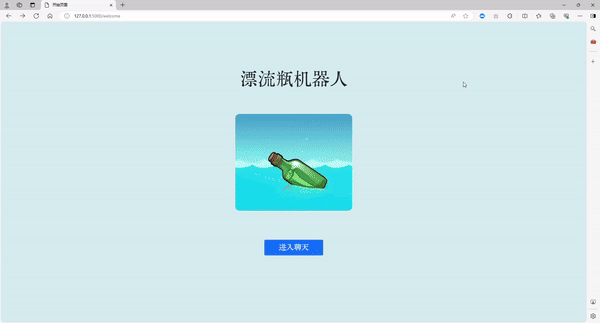
page1
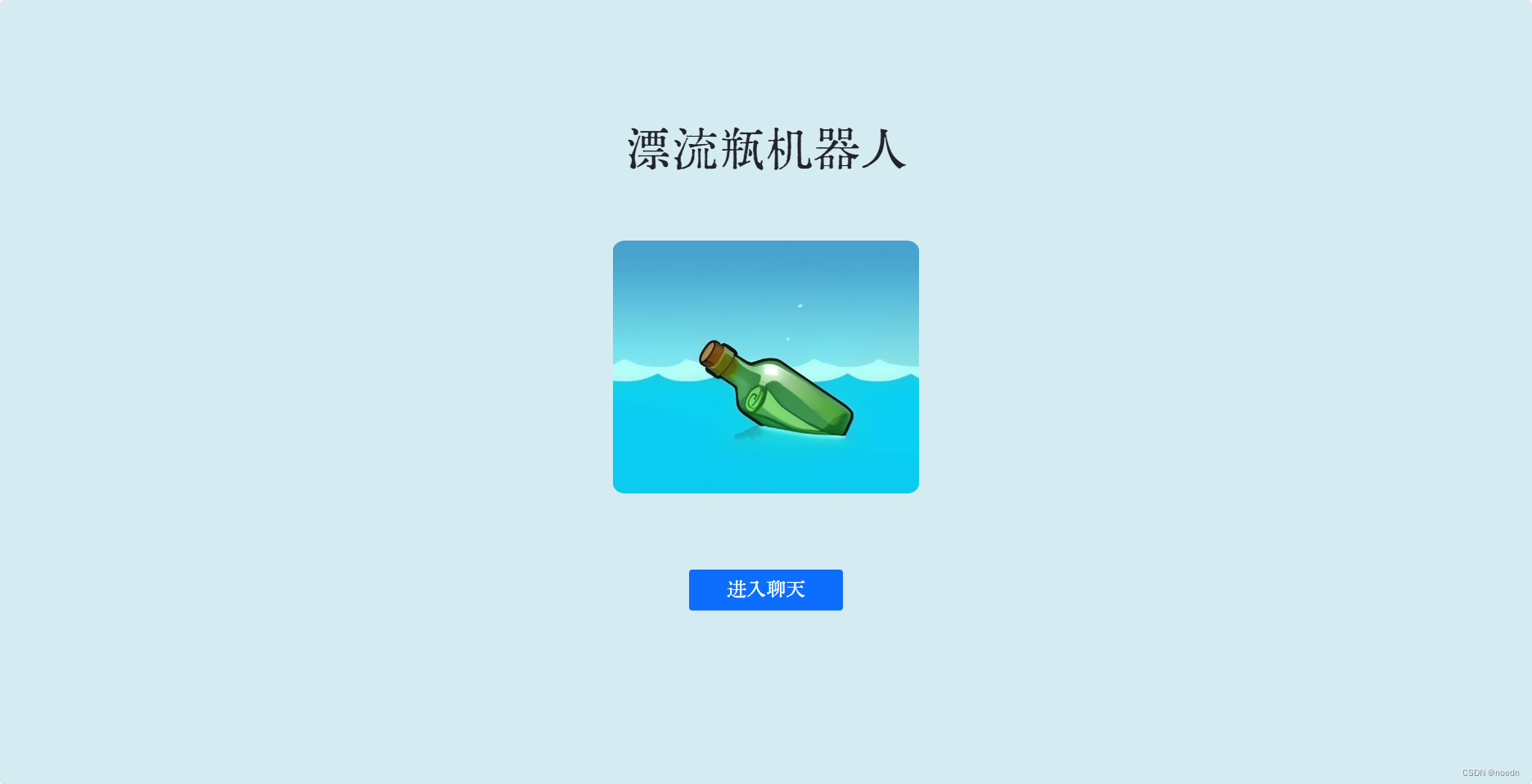
page2

page3
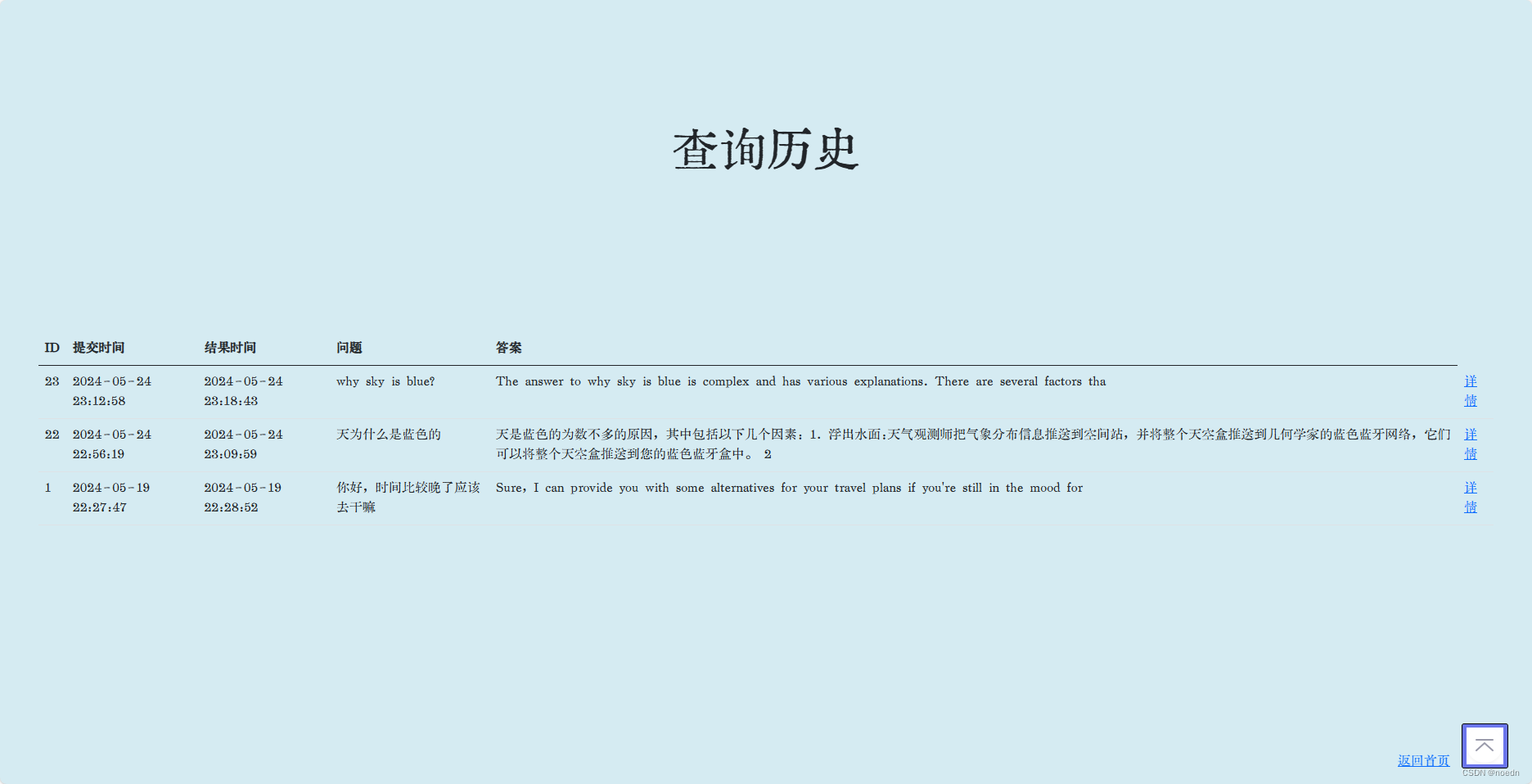
page4






















 792
792

 被折叠的 条评论
为什么被折叠?
被折叠的 条评论
为什么被折叠?








